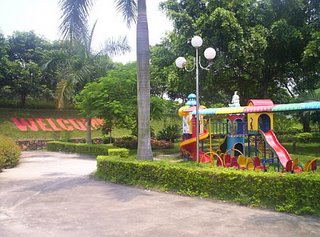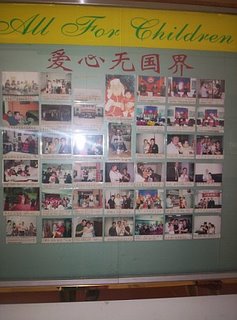
by Seth Freeman
Playground on the grounds of an orphanage one hour outside of Guangzhou.
In late July 2006, I had the privilege of spending a morning visiting an orphanage located one hour outside of Guangzhou. I went in the hope that my visit would help me better understand the early life of the child we hope to adopt. I would like to share a few impressions, surprises, and insights for the benefit of other waiting adoptive parents.
I was permitted to spend an hour visiting and playing with about 50 of the 90 children in the orphanage. The children I met ranged in age from infants to five year olds (older children were in school at the time). I had this privilege thanks to the generous efforts of Gladney's China program and its associates in China. Samson served as my guide and interpreter, driving me to the orphanage and introducing me to the assistant director. I was in the area because I had just finished teaching some classes, through interpreters, at a business school in Guangzhou.

Inside the orphanage. My hosts asked me to please refrain from photographing the children. They kindly allowed me to visit with ~50 infants, toddlers, and 5 year olds. Facilities and care seemed excellent.
I was pleasantly surprised by the excellent conditions of the orphanage (or, as I learned they call it, the Social Welfare Institution). I will describe the conditions in a moment. First though, I would like to describe the children’s response to my visit, which also surprised me.
The Children and Their Response
The moment I entered the kindergarten common room, one child literally raced over to me and grabbed my leg as if I were her dearest uncle. She would not let go. She giggled and beamed at any attention I gave her, and pushed away other children who came over to me. So sweet and painful. I tried, with mixed success, to play with each of the ten children there.
In another room, twelve-month olds were standing in modern plastic walkers looking bewildered as children that age often do. I played with them for a while and then stepped away to take in the room. When I looked down, I found that two or three of them were silently inching their walkers over toward me, like little friendly creatures.
I also visited about 40 infants in a large nursery on the same floor. Each was resting in her own crib. Later, I learned that some of these infants cried when I left. From these moments, I saw that the children are hungry for love and emotional support, as you might expect. They are materially well provided for and well cared for.
The Excellent Conditions
I was impressed with the care the staff. I learned that there are 20 caregivers for about 90 children, including two doctors and six nurses. In the nursery, I saw nurses carefully tending to one infant who had a heat blister on her head. This seemed to be a common health issue as I saw a few infants with gauze pads on their heads. But generally, they seemed healthy and comfortable.
Each infant had her own sturdy, chrome crib, and a blanket. But to my surprise, each child slept on the hard wood floor of her crib, with no mattress. I learned later that spilled food on clothe causes smells. Rather than constantly washing the bed mattresses, the staff decided to remove them. Bad practice? Well, it turns out that most Chinese sleep on hard floor beds without mattresses. The older Chinese rest their heads on stone pillows. I learned that this practice doesn't seem to cause any problems.
Most of the children I met were girls. However, I must confess, it wasn't always easy to tell because their hair was quite short. A few of the children were developmentally disabled or had birth defects such as cleft palates. I later learned that the children with cleft palates would receive corrective surgery. Each child was well clothed and seemed quite well-nourished. I heard few unhappy sounds. This good care seems to extend well into their young adult life. I learned that orphans can go on to college if they so desire, at no charge.
The rooms in which the children lived looked and smelled clean. However, forty-five diapered children in a large, warm room will have a bit of a scent. While sitting in the play area on low seats, caretakers hand feed a tasty looking meal to toddlers. Older children eat together at a table in a separate dining room. Infants receive a bottle, one of which I saw resting beside a sleeping baby. Kindergartners had a small, cheerful classroom, and they were happy to sing me the "ABC" song when their caretaker prompted them to. The caretakers live on the premises most of the week and visiting their own families during their days off.
At the request of the assistant director, I refrained from taking pictures of the children. She allowed me to take pictures of the facilities.
The Social Welfare Institution ("SWI") even had its own small farm, complete with pigs, fruit trees, and vegetable plants that supplement the children’s diet. The building itself consisted of a modern, white tiled, two story rectangle with a lovely trellised garden in the center, complete with a man-made brook. In the front of the main building were green lawns with colorful, modern playground equipment and smiling plastic animals.
Photos at the orphanage of children with their adoptive parents.
A Lunch Conversation with the Assistant Director
During lunch with Samson and the assistant director, I asked her "besides love, what should adoptive parents give their children?" She replied that "the children here have the basic necessities of life, but what they lack is the time and nurturing a parent can give." I would say that adoptive parents should realize that the children need time and attention far more than they need materialistic things. I also asked the dumb, central question I have periodically asked other people during the adoption process: "are the children better off being adopted?" To paraphrase her reply, "Yes. We can give a child the basics, but we are caregivers, not parents. We can't give a child the attention, the emotional support, and the time a parent can."
I also asked what we should consider in choosing a name. "It’s good if the child retains some sense of where she comes from, though it’s okay to give the child a different name. So, for example, a name like, Cathy Guilin Hopper might be good." At this SWI, the assistant director told me that a child receives a name based on (1) where she was found and (2) the personality she seems to have. So, for example, a child might have the name, ‘Cheerful Guilin’ or ‘Quiet Park.’
I consider the kindness the staff showed me to be a great gift and I am very grateful. I do not know how open the staff will be to further visits. I sensed it might be burdensome and I was at pains not to be too intrusive. My overall impression is that the staff and the government are doing an excellent job for the children. However, adoption is a blessing for them. I am also very grateful to Gongzhan and Samson for their generosity in making the arrangements for this extraordinary visit.
_____________________________________
No comments:
Post a Comment